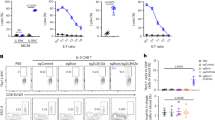Abstract
THERE is evidence that both a hypoxic stimulus, such as high altitude exposure, and an immunogenic stimulus act by inducing cell differentiation of some pluripotential stem cell1,2. It may or may not be the same pluripotential stem cell on which these stimuli act, the former causing differentiation into erythrocytes, the latter into lymphoid cells which produce antibody (Ab). Recent results have shown that a hypoxic stimulus also increases the immune response of animals exposed to chronic high altitude3–5. This suggests that perhaps there is a synergistic action between the two stimuli on a common target cell or organ. If cell differentiation is involved in the synergistic action, then two simultaneous stimuli of equal duration applied to undifferentiated stem cells would be expected to be more effective in producing a demonstrable increase in the immune response than separate, successive applications of the two stimuli.
This is a preview of subscription content, access via your institution
Access options
Subscribe to this journal
Receive 51 print issues and online access
$199.00 per year
only $3.90 per issue
Buy this article
- Purchase on Springer Link
- Instant access to full article PDF
Prices may be subject to local taxes which are calculated during checkout
Similar content being viewed by others
References
Van Liere, E. J., and Stickney, J. C., Hypoxia (The University of Chicago Press, Chicago, 1963).
Reynatarje, C., in The Physiological Effects of High Altitude (edit. by Weihe, W. H.), 73 (Macmillan, New York, 1964).
Trapani, I. L., in The Physiological Effects of High Altitude (edit. by Weihe, W. H.), 167 (Macmillan, New York, 1964).
Altland, P. D., Highman, B., and Smith, F., J. Infect. Dis., 113, 228 (1963).
Trapani, I. L., Fed. Proc., 25, 1254 (1966).
Carpenter, P. L., Immunology and Serology, 125 (W. B. Saunders. Philadelphia, 1965).
Stavitsky, A. B., and Arquilla, E. R., J. Immunol., 74, 306 (1955).
Jerne, N. K., and Nordin, A. A., Science, 140, 405 (1963).
Sainte Marie, G., J. Cell. Physiol., 67, suppl. 1, part II, 109 (1966).
Lajtha, L. G., J. Cell. Physiol., 67, suppl. 1, part II, 133 (1966).
Lajtha, L. G., in Erythropoiesis (edit. by Jacobson, L. O., and Doyle, M.) 140 (Grune and Stratton, New York, 1962).
Stavitsky, A. B., in Reticulo Endothelial Structure and Function (edit. by Heller, J. H.), 91 (The Ronald Press, New York, 1960).
Mauzerall, D., and Granick, S., J. Biol. Chem., 219, 435 (1956).
Tengerdy, R. P., Cancer Res., 26, part I, 312 (1966).
Author information
Authors and Affiliations
Rights and permissions
About this article
Cite this article
TENGERDY, R., KRAMER, T. Immune Response of Rabbits during Short Term Exposure to High Altitude. Nature 217, 367–369 (1968). https://doi.org/10.1038/217367a0
Received:
Issue Date:
DOI: https://doi.org/10.1038/217367a0
This article is cited by
-
Immune response in human subjects at high altitude
International Journal of Biometeorology (1975)
Comments
By submitting a comment you agree to abide by our Terms and Community Guidelines. If you find something abusive or that does not comply with our terms or guidelines please flag it as inappropriate.



